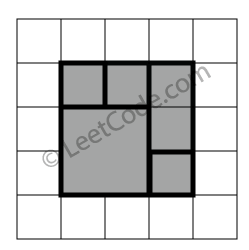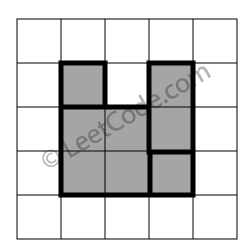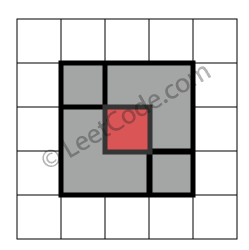391. Perfect Rectangle
Problem:
Given N axis-aligned rectangles where N > 0, determine if they all together form an exact cover of a rectangular region.
Each rectangle is represented as a bottom-left point and a top-right point. For example, a unit square is represented as [1,1,2,2]. (coordinate of bottom-left point is (1, 1) and top-right point is (2, 2)).
Example 1:
rectangles = [
[1,1,3,3],
[3,1,4,2],
[3,2,4,4],
[1,3,2,4],
[2,3,3,4]
]
Return true. All 5 rectangles together form an exact cover of a rectangular region.
 Example 2:
Example 2:
rectangles = [
[1,1,2,3],
[1,3,2,4],
[3,1,4,2],
[3,2,4,4]
]
Return false. Because there is a gap between the two rectangular regions.
 Example 3:
Example 3:
rectangles = [
[1,1,3,3],
[3,1,4,2],
[1,3,2,4],
[3,2,4,4]
]
Return false. Because there is a gap in the top center.
 Example 4:
Example 4:
rectangles = [
[1,1,3,3],
[3,1,4,2],
[1,3,2,4],
[2,2,4,4]
]
Return false. Because two of the rectangles overlap with each other.

Solutions:
Not working solution
public class Solution {
public boolean isRectangleCover(int[][] rectangles) {
int blox = Integer.MAX_VALUE, bloy = Integer.MAX_VALUE, trix = Integer.MIN_VALUE, triy = Integer.MIN_VALUE;
for (int i = 0; i < rectangles.length; i ++) {
int[] rect = rectangles[i];
if (!(rect[0] > blox || rect[1] > bloy)) {
blox = rect[0];
bloy = rect[1];
}
if (!(rect[2] < trix || rect[3] < triy)) {
trix = rect[2];
triy = rect[3];
}
}
System.out.println(blox + ", " + bloy + " : " + trix + ", " + triy);
boolean[][] covered = new boolean[trix - blox][triy - bloy];
for (int i = 0; i < rectangles.length; i ++) {
int[] rect = rectangles[i];
for (int m = rect[0] - blox; m < rect[2] - blox; m ++) {
for (int n = rect[1] - bloy; n < rect[3] - bloy; n ++) {
if (m < 0 || m >= covered.length || n < 0 || n >= covered[0].length) {
System.out.println("out of bound");
return false;
}
if (covered[m][n] == true) {
return false;
}
covered[m][n] = true;
}
}
}
for (int i = 0; i < covered.length; i ++) {
for (int j = 0; j < covered[0].length; j ++) {
if (covered[i][j] == false) {
return false;
}
}
}
return true;
}
}
Working solution
public class Solution {
public boolean isRectangleCover(int[][] rectangles) {
int blox = Integer.MAX_VALUE, bloy = Integer.MAX_VALUE, trix = Integer.MIN_VALUE, triy = Integer.MIN_VALUE;
int area = 0;
HashMap<String, Integer> data = new HashMap<String, Integer>();
for (int i = 0; i < rectangles.length; i ++) {
int[] rect = rectangles[i];
blox = Math.min(blox, rect[0]);
bloy = Math.min(bloy, rect[1]);
trix = Math.max(trix, rect[2]);
triy = Math.max(triy, rect[3]);
area += (rect[2] - rect[0]) * (rect[3] - rect[1]);
if (!isValid(data, rect[0] + "," + rect[1], 1)) {
return false;
}
if (!isValid(data, rect[0] + "," + rect[3], 2)) {
return false;
}
if (!isValid(data, rect[2] + "," + rect[1], 4)) {
return false;
}
if (!isValid(data, rect[2] + "," + rect[3], 8)) {
return false;
}
}
int count = 0;
for (String s:data.keySet()) {
int val = data.get(s);
if (val == 1 || val == 2 || val == 4 || val == 8) {
count ++;
}
}
return count == 4 && (trix - blox) * (triy - bloy) == area;
}
private boolean isValid(HashMap<String, Integer> data, String key, int mask) {
if (data.containsKey(key) && (data.get(key)&mask) != 0) {
return false;
}
int val = 0;
if (data.containsKey(key)) {
val = data.get(key);
}
val = val | mask;
data.put(key, val);
return true;
}
}
Another working solutions.
public class Solution {
public boolean isRectangleCover(int[][] rectangles) {
int blox = Integer.MAX_VALUE, bloy = Integer.MAX_VALUE, trix = Integer.MIN_VALUE, triy = Integer.MIN_VALUE;
int area = 0;
Set<String> points = new HashSet<String>();
for (int i = 0; i < rectangles.length; i ++) {
int[] rect = rectangles[i];
blox = Math.min(blox, rect[0]);
bloy = Math.min(bloy, rect[1]);
trix = Math.max(trix, rect[2]);
triy = Math.max(triy, rect[3]);
area += (rect[2] - rect[0]) * (rect[3] - rect[1]);
String[] ps = new String[4];
ps[0] = rect[0] + "," + rect[1];
ps[1] = rect[0] + "," + rect[3];
ps[2] = rect[2] + "," + rect[1];
ps[3] = rect[2] + "," + rect[3];
for (int j = 0; j < ps.length; j ++) {
if (points.contains(ps[j])) {
points.remove(ps[j]);
}
else {
points.add(ps[j]);
}
}
}
String[] ps = new String[4];
ps[0] = blox + "," + bloy;
ps[1] = blox + "," + triy;
ps[2] = trix + "," + bloy;
ps[3] = trix + "," + triy;
for (int i = 0; i < ps.length; i ++) {
if (!points.contains(ps[i])) {
return false;
}
}
return points.size() == 4 && (trix - blox) * (triy - bloy) == area;
}
}